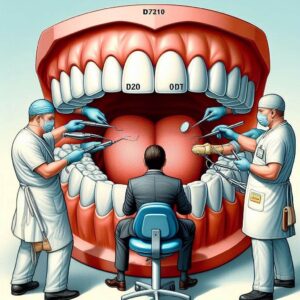Dental Code D7210 vs. D7140: A Comprehensive Guide for Dental Professionals
Dental extractions are among the most common procedures in oral surgery, but selecting the correct billing code is crucial for accurate reimbursement and patient care. Two frequently used codes—D7210 (surgical extraction of an erupted tooth) and D7140 (simple extraction of an erupted tooth)—often cause confusion among dental professionals.
This article provides an in-depth comparison of D7210 vs. D7140, covering their definitions, clinical applications, billing implications, and real-world examples. Whether you’re a dentist, dental assistant, or billing specialist, this guide will help you navigate these codes with confidence.

2. Understanding Dental Extraction Codes
Dental procedures are categorized by the American Dental Association (ADA) Current Dental Terminology (CDT), which standardizes codes for billing and documentation. Extractions fall under different codes based on complexity:
- Simple Extractions (D7140) – Removal of fully erupted teeth with minimal complications.
- Surgical Extractions (D7210) – Involves sectioning, flap elevation, or bone removal.
Choosing the right code ensures proper insurance claims and avoids denials.
3. What is D7210?
Definition and Description
D7210 refers to the surgical extraction of an erupted tooth requiring elevation of mucoperiosteal flap and removal of bone or sectioning of the tooth.
When is D7210 Used?
- Impacted or fractured teeth needing surgical intervention.
- Teeth with curved roots requiring sectioning.
- Cases where bone removal is necessary for extraction.
Clinical Considerations
- Requires local anesthesia (sometimes sedation).
- Post-operative care includes sutures and pain management.
4. What is D7140?
Definition and Description
D7140 describes a simple extraction of an erupted tooth without complications.
When is D7140 Used?
- Mobile teeth due to periodontal disease.
- Non-impacted, fully erupted teeth with straight roots.
- No need for flap elevation or bone removal.
Clinical Considerations
- Performed with forceps and elevators.
- Minimal post-operative discomfort.
5. Key Differences Between D7210 and D7140
| Feature | D7210 (Surgical Extraction) | D7140 (Simple Extraction) |
|---|---|---|
| Complexity | High (flap, bone removal) | Low (forceps only) |
| Tooth Condition | Impacted, fractured, curved roots | Fully erupted, mobile teeth |
| Anesthesia | Local + possible sedation | Local anesthesia only |
| Recovery Time | Longer (sutures needed) | Shorter (minimal aftercare) |
Surgical vs. Non-Surgical Extraction
- D7210 involves osteotomy (bone cutting) or tooth sectioning.
- D7140 is a non-invasive procedure.
6. Billing and Coding Considerations
Insurance Coverage
- D7140 is often fully covered under basic dental plans.
- D7210 may require pre-authorization due to higher complexity.
Documentation Requirements
- D7210: Must include radiographs, surgical notes, and justification for surgical approach.
- D7140: Requires tooth condition description and extraction method.
7. Case Studies and Real-World Examples
Case 1: Surgical Extraction (D7210)
A 35-year-old patient with a horizontally impacted molar required flap elevation and bone removal. D7210 was billed.
Case 2: Simple Extraction (D7140)
A 60-year-old patient with advanced periodontal disease had a mobile tooth extracted with forceps. D7140 was applied.
8. Frequently Asked Questions (FAQs)
Q1: Can D7210 and D7140 be billed together?
No, they are mutually exclusive.
Q2: Does medical insurance cover D7210?
Sometimes, if medically necessary (e.g., trauma or infection).
Q3: What if a simple extraction turns surgical?
The code should be updated to D7210 if bone removal or sectioning is performed.
9. Conclusion
Understanding D7210 vs. D7140 ensures accurate billing and optimal patient care. D7210 applies to complex extractions requiring surgery, while D7140 is for straightforward cases. Proper documentation and coding prevent claim denials and improve practice efficiency.


